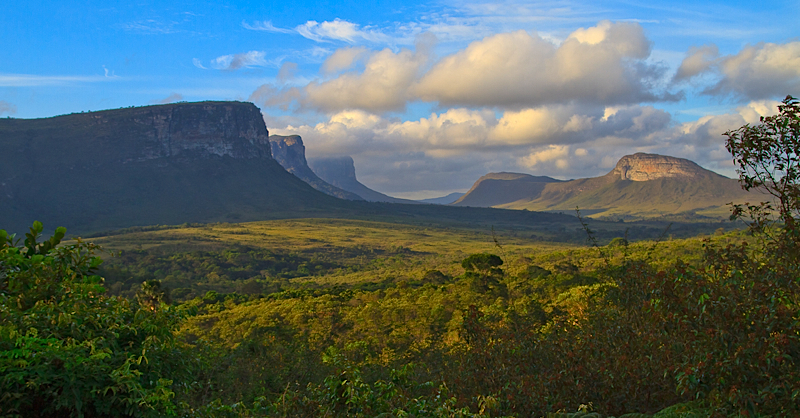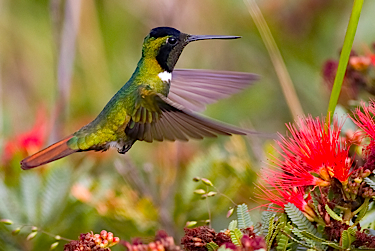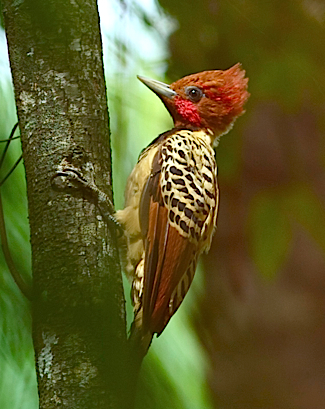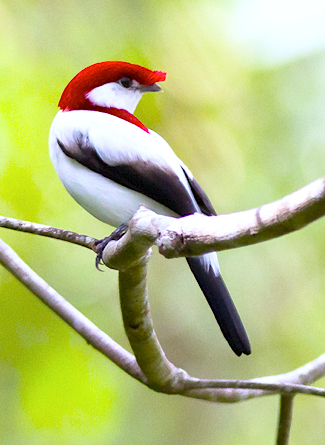For our tour description, itinerary,
past triplists, dates, fees, and more, please VISIT OUR TOUR PAGE.
See this triplist in printable PDF format with media only on
page 1.

The scenic Chapada
Diamantina in the state of Bahia. Only some of its mountains
have been explored biologically; who knows what remains to
be found? (Photo by tour participant Markus Lagerqvist)
Northeast Brazil is the cradle of Brazil, the place where the
first explorers arrived and the area where the first settlers
began to colonize the country. So it comes as no surprise that
it’s by far one of the most impacted and altered areas in the
country. The remaining areas of habitat are few and far
between, and the constant pressure from human activities poses
an enormous threat to those areas remaining. Planning a tour
to Northeast Brazil is no easy task. In the nineteen years
we’ve been running the tour, we’ve seen birds disappear
entirely from the wild (Spix’s Macaw), and sadly, things are
not looking good for a few other species that we currently see
on our tour. Each year as new information comes to light and
new sites become available, we reevaluate the route, adding
new areas that are promising. Last year we decided to break
the tour into two parts that complement each other and so make
it possible for people with limited time to take part in this
amazing journey. This was the debut of our new Itinerary, and
we can now say it was a great success!
Part I started off with a bang as we managed to get great
looks at Forbes’s Blackbird, White-collared Kite (seen three
times on this tour), Orange-bellied Antwren, and Alagoas
Tyrannulet on the first few days of the tour, not to mention
some very cooperative Golden-tailed Parrotlets. We reached the
Little Wood-Rail spot just in time to see it before the tide
came in, and thanks to Kent, we saw Comb Duck, Southern
Pochard, White-cheeked Pintail, Brazilian Teal, Fulvous,
White-faced, and Black-bellied whistling-ducks, and Muscovy
Duck all in one shot at a lake he discovered on a walk after
lunch. Later on we found hundreds of Masked Ducks in another
spot, making this one of the best years ever for ducks!
We had an incredibly well-behaved male Araripe Manakin that
was one of the highlights of the tour, and who could forget
the wonderful views of Lear’s Macaws foraging, a sign of hope
for this incredibly endangered bird. Thanks to a new flight
that spared us from having to drive back to Salvador, we were
able to visit a new area where we saw Diamantina Tapaculo,
Rufous-sided Pigmy-Tyrant, and Gray-backed Tachuri. But the
true highlight of this side trip was a good patch of flowering
Cerrado that was more productive than many hummingbird feeders
I have been to. We came away with no fewer than 10 species of
hummers, among which were Horned Sungem, Brown Violetear,
Hooded Visorbearer (which we had already seen amazingly well
the previous day!), Amethyst Woodstar, and gorgeous looks at
Ruby-topaz Hummingbird. This was truly a memorable moment for
all of us. We then headed back to the historical city of
Salvador, where a few friends left us and some new
participants jumped aboard for the exciting days that
followed.
Part II borrowed some of its days from our original tour, and
they were as usual very productive and enjoyable, with
wonderful views of Slender Antbird, Narrow-billed Antwren, and
a myriad of furnariids that included the Striated Softtail and
Bahia Spinetail, a bird that was named after our own Bret
Whitney. How often do you get to see a bird named after the
person who is showing it to you? But the overlap with the old
tour stopped here. The rest of the tour featured several new
areas and added many high quality birds to our list. In Porto
Seguro, Mike got us on that Banded Cotinga, we had pretty good
looks at Hook-billed Hermit, and a White-winged Potoo showed
beautifully. Our visit to Minas Gerais had us collecting
rarities left and right, with Minas Gerais Tyrannulet,
Moustached Woodcreeper, Bahian Nighthawk, and Chestnut-capped
Foliage-gleaner. In the state of Tocantins, we enjoyed the
delights of Brazilian country life in a lovely family-run
lodge, and it was there that we saw an undescribed species of
spinetail, Crimson-fronted Cardinal, Bananal Antbird, Orinoco
Goose, and had stunning looks at a Kaempfer’s Woodpecker, a
bird that had us worried for a while.
Bret and I had a great time leading this tour, and we have
all of you to thank for this. We are already looking forward
to next year. Thanks again for joining us, and we hope to meet
again some time soon. Good Birding!
--Marcelo
PS: This list includes the birds recorded on part I and part
II of the tour and the parts of the tour on which they were
seen are noted next to each bird. If the note is followed by
an asterisk it means that it was only heard on that segment of
the tour ie. I/II* ( Bird was seen on part I and heard only on
part II )
For more information about this tour, including future
departures, visit our website at www.fieldguides.com.
And to see this same triplist online, go to https://fieldguides.com/triplists/neb12LIST.pdf
and you will find the list in its entirety.
KEYS FOR THIS LIST
One of the following keys may be shown in brackets for
individual species as appropriate: * = heard only, I =
introduced, E = endemic, N = nesting, a = austral migrant, b =
boreal migrant
Rheidae (Rheas)
GREATER RHEA (Rhea americana)
Tinamidae (Tinamous)
LITTLE TINAMOU (Crypturellus soui)
UNDULATED TINAMOU
(Crypturellus undulatus)
VARIEGATED TINAMOU
(Crypturellus variegatus)
SMALL-BILLED
TINAMOU (Crypturellus
parvirostris)
TATAUPA TINAMOU
(Crypturellus tataupa)
RED-WINGED TINAMOU
(Rhynchotus rufescens)
WHITE-BELLIED
NOTHURA (Nothura boraquira)
Anhimidae (Screamers)
HORNED SCREAMER (Anhima cornuta)
Anatidae (Ducks, Geese, and Waterfowl)
WHITE-FACED WHISTLING-DUCK (Dendrocygna viduata)
BLACK-BELLIED
WHISTLING-DUCK (Dendrocygna
autumnalis)
FULVOUS
WHISTLING-DUCK (Dendrocygna
bicolor)
COMB DUCK (Sarkidiornis melanotos)
ORINOCO GOOSE
(Neochen jubata)
MUSCOVY DUCK
(Cairina moschata)
BRAZILIAN TEAL
(Amazonetta brasiliensis)
WHITE-CHEEKED
PINTAIL (Anas bahamensis)

Occuring widely
through the world's tropical regions, the unique Comb Duck
is better known as Knob-billed Duck in the Old World
regions; the name certainly fits the New World birds, too!
(Photo by tour participant Markus Lagerqvist)
SOUTHERN POCHARD (Netta erythrophthalma)
MASKED DUCK
(Nomonyx dominicus)
Cracidae (Guans, Chachalacas, and
Curassows)
SPECKLED CHACHALACA (EAST BRAZILIAN)
(Ortalis guttata araucuan)
RUSTY-MARGINED
GUAN (Penelope superciliaris)
BARE-FACED
CURASSOW (Crax fasciolata)
Odontophoridae (New World Quail)
SPOT-WINGED WOOD-QUAIL (Odontophorus capueira)
Podicipedidae (Grebes)
LEAST GREBE (Tachybaptus dominicus)
PIED-BILLED GREBE
(Podilymbus podiceps)
Ciconiidae (Storks)
JABIRU (Jabiru
mycteria)
WOOD STORK
(Mycteria americana)
Phalacrocoracidae (Cormorants and Shags)
NEOTROPIC CORMORANT (Phalacrocorax brasilianus)
Anhingidae (Anhingas)
ANHINGA (Anhinga
anhinga)
Ardeidae (Herons, Egrets, and Bitterns)
PINNATED BITTERN (Botaurus pinnatus)
RUFESCENT
TIGER-HERON (Tigrisoma
lineatum)
COCOI HERON
(Ardea cocoi)
GREAT EGRET
(Ardea alba)
SNOWY EGRET
(Egretta thula)
LITTLE BLUE HERON
(Egretta caerulea)
CATTLE EGRET
(Bubulcus ibis)
STRIATED HERON
(Butorides striata)
WHISTLING HERON
(Syrigma sibilatrix)
CAPPED HERON
(Pilherodius pileatus)
BLACK-CROWNED
NIGHT-HERON (Nycticorax
nycticorax)
YELLOW-CROWNED
NIGHT-HERON (Nyctanassa
violacea)
Threskiornithidae (Ibises and Spoonbills)
GREEN IBIS (Mesembrinibis
cayennensis)
BARE-FACED IBIS
(Phimosus infuscatus)
BUFF-NECKED IBIS
(Theristicus caudatus)
ROSEATE SPOONBILL
(Platalea ajaja)
Cathartidae (New World Vultures)
BLACK VULTURE (Coragyps atratus)
TURKEY VULTURE
(Cathartes aura)
LESSER
YELLOW-HEADED VULTURE (Cathartes
burrovianus)
KING VULTURE
(Sarcoramphus papa)
Pandionidae (Osprey)
OSPREY (Pandion
haliaetus)
Accipitridae (Hawks, Eagles, and Kites)
GRAY-HEADED KITE (Leptodon cayanensis)
WHITE-COLLARED
KITE (Leptodon forbesi)
[E]
WHITE-TAILED KITE
(Elanus leucurus)
SNAIL KITE
(Rostrhamus sociabilis)
DOUBLE-TOOTHED
KITE (Harpagus bidentatus)
RUFOUS-THIGHED
KITE (Harpagus diodon)
PLUMBEOUS KITE
(Ictinia plumbea)
BLACK-COLLARED
HAWK (Busarellus nigricollis)
BLACK-CHESTED
BUZZARD-EAGLE (Geranoaetus
melanoleucus)
CRANE HAWK
(BANDED) (Geranospiza
caerulescens gracilis)
MANTLED HAWK
(Leucopternis polionotus)
[E]
GREAT BLACK-HAWK
(Buteogallus urubitinga)
SAVANNA HAWK
(Buteogallus meridionalis)
HARRIS'S HAWK
(Parabuteo unicinctus)
ROADSIDE HAWK
(Buteo magnirostris)
GRAY HAWK (Buteo nitidus)
SHORT-TAILED HAWK
(Buteo brachyurus)
WHITE-TAILED HAWK
(Buteo albicaudatus)
ZONE-TAILED HAWK
(Buteo albonotatus)
BLACK HAWK-EAGLE
(Spizaetus tyrannus)
Falconidae (Falcons and Caracaras)
COLLARED FOREST-FALCON (Micrastur semitorquatus)
SOUTHERN CARACARA
(Caracara plancus)
YELLOW-HEADED
CARACARA (Milvago chimachima)
LAUGHING FALCON
(Herpetotheres cachinnans)
AMERICAN KESTREL
(Falco sparverius)
APLOMADO FALCON
(Falco femoralis)
BAT FALCON
(Falco rufigularis)
Cariamidae (Seriemas)
RED-LEGGED SERIEMA (Cariama cristata)
Eurypygidae (Sunbittern)
SUNBITTERN (Eurypyga
helias)
Rallidae (Rails, Gallinules, and Coots)
RUFOUS-SIDED CRAKE (Laterallus melanophaius)
GRAY-BREASTED
CRAKE (Laterallus exilis)
GIANT WOOD-RAIL
(Aramides ypecaha)
LITTLE WOOD-RAIL
(Aramides mangle)
GRAY-NECKED
WOOD-RAIL (Aramides cajanea)
ASH-THROATED CRAKE
(Porzana albicollis)
PURPLE GALLINULE
(Porphyrio martinica)
AZURE GALLINULE
(Porphyrio flavirostris)
COMMON GALLINULE
(Gallinula galeata)
Heliornithidae (Finfoots)
SUNGREBE (Heliornis
fulica)
Aramidae (Limpkin)
LIMPKIN (Aramus
guarauna)
Charadriidae (Plovers and Lapwings)

The Cactus
Parakeet, aka Caatinga Parakeet, is a common endemic
throughout the caatinga and cerrado habitats visited on
this tour. (Photo by tour participant Markus Lagerqvist)
PIED LAPWING (Vanellus cayanus)
SOUTHERN LAPWING
(Vanellus chilensis)
COLLARED PLOVER
(Charadrius collaris)
SEMIPALMATED
PLOVER (Charadrius
semipalmatus)
Recurvirostridae (Stilts and Avocets)
BLACK-NECKED STILT (Himantopus mexicanus)
Jacanidae (Jacanas)
WATTLED JACANA (Jacana jacana)
Scolopacidae (Sandpipers and Allies)
SPOTTED SANDPIPER (Actitis macularius)
SOLITARY SANDPIPER
(Tringa solitaria)
WILLET (Tringa semipalmata)
WHIMBREL (Numenius phaeopus)
RUDDY TURNSTONE
(Arenaria interpres)
SEMIPALMATED
SANDPIPER (Calidris pusilla)
SOUTH AMERICAN
SNIPE (Gallinago paraguaiae)
Laridae (Gulls, Terns, and Skimmers)
LARGE-BILLED TERN (Phaetusa simplex)
SANDWICH TERN
(CAYENNE) (Thalasseus
sandvicensis eurygnathus)
Columbidae (Pigeons and Doves)
ROCK PIGEON (Columba livia)
PALE-VENTED PIGEON
(Patagioenas cayennensis)
SCALED PIGEON
(Patagioenas speciosa)
PICAZURO PIGEON
(Patagioenas picazuro)
PLUMBEOUS PIGEON
(Patagioenas plumbea)
EARED DOVE
(Zenaida auriculata)
PLAIN-BREASTED
GROUND-DOVE (Columbina minuta)
RUDDY GROUND-DOVE
(Columbina talpacoti)
SCALED DOVE
(Columbina squammata)
PICUI GROUND-DOVE
(Columbina picui)
BLUE GROUND-DOVE
(Claravis pretiosa)
LONG-TAILED
GROUND-DOVE (Uropelia
campestris)
WHITE-TIPPED DOVE
(Leptotila verreauxi)
GRAY-FRONTED DOVE
(Leptotila rufaxilla)
Psittacidae (Parrots)
BLUE-THROATED PARAKEET (Pyrrhura cruentata)
MAROON-BELLIED
PARAKEET (Pyrrhura frontalis)
GRAY-BREASTED
PARAKEET (Pyrrhura
griseipectus) [E]
WHITE-EYED
PARAKEET (Aratinga
leucophthalma)
GOLDEN-CAPPED
PARAKEET (Aratinga
auricapillus)
[E]
PEACH-FRONTED
PARAKEET (Aratinga aurea)
CACTUS PARAKEET
(Aratinga cactorum) [E]
INDIGO MACAW
(Anodorhynchus leari) [E]
BLUE-AND-YELLOW
MACAW (Ara ararauna)
BLUE-WINGED MACAW
(Primolius maracana)
YELLOW-COLLARED
MACAW (Primolius auricollis)
RED-SHOULDERED
MACAW (Diopsittaca nobilis)
BLUE-WINGED
PARROTLET (Forpus
xanthopterygius)
PLAIN PARAKEET
(Brotogeris tirica)
YELLOW-CHEVRONED
PARAKEET (Brotogeris chiriri)
GOLDEN-TAILED
PARROTLET (Touit surdus)
BLUE-HEADED PARROT
(Pionus menstruus)
BLUE-HEADED PARROT
(REICHENOW'S) (Pionus
menstruus reichenowi)
[E]
SCALY-HEADED
PARROT (Pionus maximiliani)
BLUE-FRONTED
PARROT (Amazona aestiva)
ORANGE-WINGED
PARROT (Amazona amazonica)
Opisthocomidae (Hoatzin)
HOATZIN (Opisthocomus
hoazin)
Cuculidae (Cuckoos)
SQUIRREL CUCKOO (Piaya cayana)
DARK-BILLED CUCKOO
(Coccyzus melacoryphus)
YELLOW-BILLED
CUCKOO (Coccyzus americanus)
PEARLY-BREASTED
CUCKOO (Coccyzus euleri)
GUIRA CUCKOO
(Guira guira)
STRIPED CUCKOO
(Tapera naevia)
PHEASANT CUCKOO
(Dromococcyx phasianellus)
GREATER ANI
(Crotophaga major)
SMOOTH-BILLED ANI
(Crotophaga ani)
Tytonidae (Barn-Owls)
BARN OWL (Tyto
alba)
Strigidae (Owls)
TROPICAL SCREECH-OWL (Megascops choliba)
SPECTACLED OWL
(Pulsatrix perspicillata)
GREAT HORNED OWL
(GREAT HORNED) (Bubo
virginianus nacurutu)
LEAST PYGMY-OWL
(Glaucidium minutissimum) [E]
FERRUGINOUS
PYGMY-OWL (Glaucidium
brasilianum)
BURROWING OWL
(Athene cunicularia)
Caprimulgidae (Nightjars and Allies)
LEAST NIGHTHAWK (Chordeiles pusillus)
LESSER NIGHTHAWK
(Chordeiles acutipennis)
COMMON NIGHTHAWK
(Chordeiles minor)
BAND-TAILED
NIGHTHAWK (Nyctiprogne
leucopyga majuscula)
BAHIAN NIGHTHAWK
(Nyctiprogne vielliardi) [E]
COMMON PAURAQUE
(Nyctidromus albicollis)

This stunning
Hooded Visorbearer was one of an amazing 10 species of
hummers that entertained us at a wonderful area of
blooming cerrado we came across on the last day of part I.
(Photo by tour participant Markus Lagerqvist)
RUFOUS NIGHTJAR (Caprimulgus rufus)
LITTLE NIGHTJAR
(Caprimulgus parvulus)
PYGMY NIGHTJAR
(Caprimulgus hirundinaceus) [E]
Nyctibiidae (Potoos)
COMMON POTOO (Nyctibius griseus)
WHITE-WINGED POTOO
(Nyctibius leucopterus)
Apodidae (Swifts)
SICK'S SWIFT (Chaetura meridionalis)
SHORT-TAILED SWIFT
(Chaetura brachyura)
BAND-RUMPED SWIFT
(Chaetura spinicaudus)
GRAY-RUMPED SWIFT
(Chaetura cinereiventris)
PALE-RUMPED SWIFT
(Chaetura egregia)
LESSER
SWALLOW-TAILED SWIFT (Panyptila
cayennensis)
FORK-TAILED
PALM-SWIFT (Tachornis
squamata)
Trochilidae (Hummingbirds)
BLACK JACOBIN (Florisuga fusca) [E]
HOOK-BILLED HERMIT
(Glaucis dohrnii) [E]
RUFOUS-BREASTED
HERMIT (Glaucis hirsutus)
BROAD-TIPPED
HERMIT (Anopetia gounellei)
[E]
REDDISH HERMIT
(Phaethornis ruber)
PLANALTO HERMIT
(Phaethornis pretrei)
SCALE-THROATED
HERMIT (Phaethornis eurynome)
HOODED VISORBEARER
(Augastes lumachella) [E]
BROWN VIOLETEAR
(Colibri delphinae)
WHITE-VENTED
VIOLETEAR (Colibri
serrirostris)
HORNED SUNGEM
(Heliactin bilophus)
BLACK-EARED FAIRY
(Heliothryx auritus)
WHITE-TAILED
GOLDENTHROAT (Polytmus
guainumbi)
RUBY-TOPAZ
HUMMINGBIRD (Chrysolampis
mosquitus)
BLACK-THROATED
MANGO (Anthracothorax
nigricollis)
RACKET-TAILED
COQUETTE (Discosura
longicaudus)
STRIPE-BREASTED
STARTHROAT (Heliomaster
squamosus) [E]
AMETHYST WOODSTAR
(Calliphlox amethystina)
GLITTERING-BELLIED
EMERALD (Chlorostilbon
aureoventris)
BLUE-CHINNED
SAPPHIRE (Chlorestes notata)
GRAY-BREASTED
SABREWING (Campylopterus
largipennis diamantinensis)
SWALLOW-TAILED
HUMMINGBIRD (Eupetomena
macroura)
FORK-TAILED
WOODNYMPH (Thalurania furcata)
LONG-TAILED
WOODNYMPH (Thalurania
watertonii) [E]
VIOLET-CAPPED
WOODNYMPH (Thalurania
glaucopis)
PLAIN-BELLIED
EMERALD (Amazilia leucogaster)
VERSICOLORED
EMERALD (Amazilia versicolor)
GLITTERING-THROATED
EMERALD (Amazilia fimbriata)
SAPPHIRE-SPANGLED
EMERALD (Amazilia lactea)
RUFOUS-THROATED
SAPPHIRE (Hylocharis
sapphirina)
WHITE-CHINNED
SAPPHIRE (Hylocharis cyanus)
Trogonidae (Trogons)
GREEN-BACKED TROGON (Trogon viridis)
BLUE-CROWNED
TROGON (Trogon curucui)
Alcedinidae (Kingfishers)
RINGED KINGFISHER (Megaceryle torquata)
AMAZON KINGFISHER
(Chloroceryle amazona)
GREEN KINGFISHER
(Chloroceryle americana)
GREEN-AND-RUFOUS
KINGFISHER (Chloroceryle inda)
AMERICAN PYGMY
KINGFISHER (Chloroceryle
aenea)
Bucconidae (Puffbirds)
WHITE-EARED PUFFBIRD (Nystalus chacuru)
SPOT-BACKED
PUFFBIRD (Nystalus maculatus)
CRESCENT-CHESTED
PUFFBIRD (Malacoptila striata)
[E]
RUSTY-BREASTED
NUNLET (Nonnula rubecula)
BLACK-FRONTED
NUNBIRD (Monasa nigrifrons)
SWALLOW-WINGED
PUFFBIRD (Chelidoptera
tenebrosa)
Galbulidae (Jacamars)
RUFOUS-TAILED JACAMAR (Galbula ruficauda)
Ramphastidae (Toucans)
LETTERED ARACARI (Pteroglossus inscriptus)
BLACK-NECKED
ARACARI (Pteroglossus aracari)
GOULD'S TOUCANET
(Selenidera gouldii)
TOCO TOUCAN
(Ramphastos toco)
CHANNEL-BILLED
TOUCAN (Ramphastos vitellinus)
Picidae (Woodpeckers)
GOLDEN-SPANGLED PICULET
(GOLDEN-SPANGLED) (Picumnus
exilis pernambucensis)
GOLDEN-SPANGLED
PICULET (GOLDEN-SPANGLED) (Picumnus
exilis exilis)

Kaempfer's
Woodpecker went missing for 80 years after its discovery
before one was finally caught in a mist net in the state
of Tocantins in 2006. Still a poorly known species, but
now a real possiblity on this tour. (Photo by guide
Marcelo Padua)
SPOTTED PICULET (Picumnus pygmaeus)
TAWNY PICULET
(Picumnus fulvescens) [E]
OCHRACEOUS PICULET
(Picumnus limae) [E]
WHITE WOODPECKER
(Melanerpes candidus)
LITTLE WOODPECKER
(Veniliornis passerinus)
RED-STAINED
WOODPECKER (Veniliornis
affinis)
YELLOW-THROATED
WOODPECKER (Piculus flavigula
erythropis) [E]
GOLDEN-GREEN
WOODPECKER (Piculus
chrysochloros)
GREEN-BARRED
WOODPECKER (Colaptes
melanochloros)
CAMPO FLICKER
(Colaptes campestris)
BLOND-CRESTED
WOODPECKER (Celeus flavescens)
[E]
BLOND-CRESTED
WOODPECKER (OCHRE-BACKED) (Celeus
flavescens ochraceus)
CREAM-COLORED
WOODPECKER (Celeus flavus)
KAEMPFER'S
WOODPECKER (Celeus obrieni)
[E]
RINGED WOODPECKER
(Celeus torquatus)
LINEATED
WOODPECKER (Dryocopus
lineatus)
CRIMSON-CRESTED
WOODPECKER (Campephilus
melanoleucos)
Furnariidae (Ovenbirds and Woodcreepers)
BLACK-TAILED LEAFTOSSER (Sclerurus caudacutus)
RUFOUS-BREASTED
LEAFTOSSER (Sclerurus scansor
cearensis) [E]
WING-BANDED
HORNERO (Furnarius figulus)
PALE-LEGGED
HORNERO (Furnarius leucopus)
RUFOUS HORNERO
(Furnarius rufus)
CHOTOY SPINETAIL
(Schoeniophylax phryganophilus)
BAHIA SPINETAIL
(Synallaxis whitneyi) [E]
PINTO'S SPINETAIL
(Synallaxis infuscata) [E]
SOOTY-FRONTED
SPINETAIL (Synallaxis
frontalis)
SPIX'S SPINETAIL
(Synallaxis spixi)
WHITE-LORED
SPINETAIL (ARAGUAIA) (Synallaxis
albilora simoni)
[E]
OCHRE-CHEEKED
SPINETAIL (Synallaxis scutata)
RED-SHOULDERED
SPINETAIL (Gyalophylax
hellmayri) [E]
GRAY-HEADED
SPINETAIL (Cranioleuca
semicinerea) [E]
YELLOW-CHINNED
SPINETAIL (Certhiaxis
cinnamomeus)
UNDESCRIBED
SPINETAIL (Certhiaxis sp.
nov.) [E]
STRIATED SOFTTAIL
(Thripophaga macroura) [E]
RUFOUS-FRONTED
THORNBIRD (RUFOUS-FRONTED) (Phacellodomus
rufifrons rufifrons)
GREATER THORNBIRD
(Phacellodomus ruber)
PINK-LEGGED
GRAVETEIRO (Acrobatornis
fonsecai) [E]
CAATINGA CACHOLOTE
(Pseudoseisura cristata) [E]
OCHRE-BREASTED
FOLIAGE-GLEANER (Philydor
lichtensteini) [E]
BUFF-FRONTED
FOLIAGE-GLEANER (Philydor
rufum)
WHITE-COLLARED
FOLIAGE-GLEANER (Anabazenops
fuscus) [E]
WHITE-EYED
FOLIAGE-GLEANER (Automolus
leucophthalmus leucophthalmus)
CHESTNUT-CAPPED
FOLIAGE-GLEANER (Hylocryptus
rectirostris) [E]
SHARP-TAILED
STREAMCREEPER (Lochmias
nematura)
GREAT XENOPS
(Megaxenops parnaguae)
[E]
PLAIN XENOPS
(Xenops minutus)
STREAKED XENOPS
(Xenops rutilans)
PLAIN-BROWN
WOODCREEPER (TAUNAYI) (Dendrocincla
fuliginosa taunayi)
[E]
PLAIN-BROWN
WOODCREEPER (PLAIN-WINGED) (Dendrocincla
fuliginosa turdina)
[E]
OLIVACEOUS
WOODCREEPER (REISER'S) (Sittasomus
griseicapillus reiseri)
[E]
OLIVACEOUS
WOODCREEPER (OLIVACEOUS) (Sittasomus
griseicapillus olivaceus)
OLIVACEOUS
WOODCREEPER (OLIVACEOUS) (Sittasomus
griseicapillus sylviellus) [E]
LONG-BILLED
WOODCREEPER (Nasica
longirostris)
MOUSTACHED
WOODCREEPER (Xiphocolaptes
falcirostris franciscanus) [E]
PLANALTO
WOODCREEPER (Dendrocolaptes
platyrostris)
STRAIGHT-BILLED
WOODCREEPER (Dendroplex picus)
LESSER WOODCREEPER
(NORTHERN) (Xiphorhynchus
fuscus atlanticus)
[E]
LESSER WOODCREEPER
(LESSER) (Xiphorhynchus fuscus
tenuirostris) [E]
BUFF-THROATED
WOODCREEPER (Xiphorhynchus
guttatus)
NARROW-BILLED
WOODCREEPER (Lepidocolaptes
angustirostris)
SCALED WOODCREEPER
(WAGLER'S) (Lepidocolaptes
squamatus wagleri)
[E]
RED-BILLED
SCYTHEBILL (Campylorhamphus
trochilirostris major)
RED-BILLED
SCYTHEBILL (Campylorhamphus
trochilirostris trochilirostris) [E]
BLACK-BILLED
SCYTHEBILL (Campylorhamphus
falcularius) [E]
Thamnophilidae (Typical Antbirds)
SPOT-BACKED ANTSHRIKE (Hypoedaleus guttatus) [E]

Stripe-backed
Antbirds are terrestrial and like to skulk around in the
dense undergrowth of dry forest where they are generally
hard to see. Guess someone forgot to tell this male that!
(Photo by guide Marcelo Padua)
TUFTED ANTSHRIKE (Mackenziaena severa) [E]
GREAT ANTSHRIKE
(Taraba major)
SILVERY-CHEEKED
ANTSHRIKE (Sakesphorus
cristatus) [E]
GLOSSY ANTSHRIKE
(Sakesphorus luctuosus)
BARRED ANTSHRIKE
(Thamnophilus doliatus)
BARRED ANTSHRIKE
(CAATINGA) (Thamnophilus
doliatus capistratus) [E]
RUFOUS-WINGED
ANTSHRIKE (Thamnophilus
torquatus)
CHESTNUT-BACKED
ANTSHRIKE (Thamnophilus
palliatus)
PLANALTO
SLATY-ANTSHRIKE (Thamnophilus
pelzelni)
SOORETAMA
SLATY-ANTSHRIKE (Thamnophilus
ambiguus) [E]
VARIABLE ANTSHRIKE
(Thamnophilus caerulescens)
WHITE-SHOULDERED
ANTSHRIKE (Thamnophilus
aethiops distans)
SPOT-BREASTED
ANTVIREO (Dysithamnus
stictothorax) [E]
PLAIN ANTVIREO
(Dysithamnus mentalis)
CINEREOUS
ANTSHRIKE (Thamnomanes
caesius)
WHITE-FLANKED
ANTWREN (Myrmotherula
axillaris)
WHITE-FLANKED
ANTWREN (SILVERY-FLANKED) (Myrmotherula
axillaris luctuosa)
[E]
BAND-TAILED
ANTWREN (Myrmotherula
urosticta) [E]
ALAGOAS ANTWREN
(Myrmotherula snowi) [E]
STRIPE-BACKED
ANTBIRD (Myrmorchilus
strigilatus strigilatus)
CAATINGA ANTWREN
(Herpsilochmus sellowi)
BAHIA ANTWREN
(Herpsilochmus pileatus) [E]
BLACK-CAPPED
ANTWREN (Herpsilochmus
atricapillus)
PECTORAL ANTWREN
(Herpsilochmus pectoralis) [E]
LARGE-BILLED
ANTWREN (Herpsilochmus
longirostris)
RUFOUS-WINGED
ANTWREN (Herpsilochmus
rufimarginatus frater)
RUFOUS-WINGED
ANTWREN (Herpsilochmus
rufimarginatus rufimarginatus) [E]
NARROW-BILLED
ANTWREN (Formicivora iheringi)
[E]
WHITE-FRINGED
ANTWREN (Formicivora grisea)
BLACK-BELLIED
ANTWREN (Formicivora
melanogaster)
RUSTY-BACKED
ANTWREN (Formicivora rufa
rufa)
SINCORA ANTWREN
(Formicivora grantsaui) [E]
FERRUGINOUS
ANTBIRD (Drymophila
ferruginea) [E]
ORANGE-BELLIED
ANTWREN (Terenura sicki)
[E]
RIO DE JANEIRO
ANTBIRD (Cercomacra
brasiliana) [E]
BANANAL ANTBIRD
(Cercomacra ferdinandi) [E]
WHITE-BACKED
FIRE-EYE (Pyriglena leuconota
pernambucensis) [E]
FRINGE-BACKED
FIRE-EYE (Pyriglena atra)
[E]
WHITE-SHOULDERED
FIRE-EYE (Pyriglena
leucoptera) [E]
SLENDER ANTBIRD
(Rhopornis ardesiacus)
[E]
SCALLOPED ANTBIRD
(Myrmeciza ruficauda) [E]
WHITE-BIBBED
ANTBIRD (Myrmeciza loricata)
[E]
Formicariidae (Antthrushes)
RUFOUS-CAPPED ANTTHRUSH (Formicarius colma)
SHORT-TAILED
ANTTHRUSH (Chamaeza
campanisona)
Grallariidae (Antpittas)
WHITE-BROWED ANTPITTA (Hylopezus ochroleucus) [E]
Conopophagidae (Gnateaters)
RUFOUS GNATEATER (CEARA) (Conopophaga lineata cearae) [E]
RUFOUS GNATEATER
(RUFOUS) (Conopophaga lineata
lineata)
BLACK-CHEEKED
GNATEATER (Conopophaga
melanops nigrifrons)
[E]
Rhinocryptidae (Tapaculos)
DIAMANTINA TAPACULO (Scytalopus diamantinensis)
Melanopareiidae (Crescentchests)
COLLARED CRESCENTCHEST (Melanopareia torquata)
Tyrannidae (Tyrant Flycatchers)
SOUTHERN BEARDLESS-TYRANNULET (Camptostoma obsoletum)
SUIRIRI FLYCATCHER
(Suiriri suiriri bahiae)
MOUSE-COLORED
TYRANNULET (Phaeomyias murina)
YELLOW TYRANNULET
(Capsiempis flaveola)
GRAY-BACKED
TACHURI (Polystictus
superciliaris) [E]
FOREST ELAENIA
(Myiopagis gaimardii)
GRAY ELAENIA
(Myiopagis caniceps)
GREENISH ELAENIA
(Myiopagis viridicata)
YELLOW-BELLIED
ELAENIA (Elaenia flavogaster)
LARGE ELAENIA
(Elaenia spectabilis)
PLAIN-CRESTED
ELAENIA (Elaenia cristata)
LESSER ELAENIA
(Elaenia chiriquensis)
HIGHLAND ELAENIA
(Elaenia obscura sordida)
OCHRE-BELLIED
FLYCATCHER (Mionectes
oleagineus)
SEPIA-CAPPED
FLYCATCHER (Leptopogon
amaurocephalus)
ALAGOAS TYRANNULET
(Phylloscartes ceciliae) [E]
MINAS GERAIS
TYRANNULET (Phylloscartes
roquettei) [E]
OUSTALET'S
TYRANNULET (Phylloscartes
oustaleti) [E]

Like many of the
antpittas in its genus, the endemic White-browed Antpitta
is a tough bird to see. We may have had to crawl around on
our hands and knees to get at this one, but this photo is
proof that hard work pays off in the end! (Photo by guide
Marcelo Padua)
PLANALTO TYRANNULET (Phyllomyias fasciatus)
GRAY-CAPPED
TYRANNULET (Phyllomyias
griseocapilla) [E]
TAWNY-CROWNED
PYGMY-TYRANT (Euscarthmus
meloryphus)
RUFOUS-SIDED
PYGMY-TYRANT (Euscarthmus
rufomarginatus)
LESSER
WAGTAIL-TYRANT (Stigmatura
napensis bahiae) [E]
GREATER
WAGTAIL-TYRANT (Stigmatura
budytoides gracilis)
[E]
EARED PYGMY-TYRANT
(Myiornis auricularis)
DRAB-BREASTED
PYGMY-TYRANT (Hemitriccus
diops) [E]
WHITE-BELLIED
TODY-TYRANT (Hemitriccus
griseipectus naumburgae)
STRIPE-NECKED
TODY-TYRANT (Hemitriccus
striaticollis)
HANGNEST
TODY-TYRANT (Hemitriccus
nidipendulus) [E]
PEARLY-VENTED
TODY-TYRANT (Hemitriccus
margaritaceiventer)
BUFF-BREASTED
TODY-TYRANT (Hemitriccus
mirandae) [E]
FORK-TAILED
PYGMY-TYRANT (Hemitriccus
furcatus) [E]
OCHRE-FACED
TODY-FLYCATCHER (Poecilotriccus
plumbeiceps)
SMOKY-FRONTED
TODY-FLYCATCHER (Poecilotriccus
fumifrons)
GRAY-HEADED
TODY-FLYCATCHER (Todirostrum
poliocephalum) [E]
COMMON
TODY-FLYCATCHER (Todirostrum
cinereum)
OLIVACEOUS
FLATBILL (Rhynchocyclus
olivaceus)
YELLOW-OLIVE
FLYCATCHER (MATO GROSSO) (Tolmomyias
sulphurescens pallescens)
YELLOW-OLIVE
FLYCATCHER (SOORETAMA) (Tolmomyias
sulphurescens sulphurescens) [E]
GRAY-CROWNED
FLYCATCHER (Tolmomyias
poliocephalus)
YELLOW-BREASTED
FLYCATCHER (Tolmomyias
flaviventris)
WHITE-THROATED
SPADEBILL (Platyrinchus
mystaceus)
CLIFF FLYCATCHER
(Hirundinea ferruginea bellicosa)
BLACK-TAILED
FLYCATCHER (Myiobius
atricaudus)
BRAN-COLORED
FLYCATCHER (Myiophobus
fasciatus)
EULER'S FLYCATCHER
(Lathrotriccus euleri)
FUSCOUS FLYCATCHER
(Cnemotriccus fuscatus)
VELVETY
BLACK-TYRANT (Knipolegus
nigerrimus) [E]
GRAY MONJITA
(Xolmis cinereus)
WHITE-RUMPED
MONJITA (Xolmis velatus)
WHITE MONJITA
(Xolmis irupero niveus) [E]
BLACK-BACKED
WATER-TYRANT (Fluvicola
albiventer)
MASKED
WATER-TYRANT (Fluvicola
nengeta)
WHITE-HEADED MARSH
TYRANT (Arundinicola
leucocephala)
LONG-TAILED TYRANT
(Colonia colonus)
CATTLE TYRANT
(Machetornis rixosa)
BRIGHT-RUMPED
ATTILA (Attila spadiceus)
SIRYSTES (Sirystes sibilator)
ASH-THROATED
CASIORNIS (Casiornis fuscus)
[E]
GRAYISH MOURNER
(Rhytipterna simplex)
DUSKY-CAPPED
FLYCATCHER (Myiarchus
tuberculifer)
SWAINSON'S
FLYCATCHER (Myiarchus
swainsoni)
SHORT-CRESTED
FLYCATCHER (Myiarchus ferox)
BROWN-CRESTED
FLYCATCHER (Myiarchus
tyrannulus)
LESSER KISKADEE
(Pitangus lictor)
GREAT KISKADEE
(Pitangus sulphuratus)
BOAT-BILLED
FLYCATCHER (Megarynchus
pitangua)
SOCIAL FLYCATCHER
(Myiozetetes similis)
STREAKED
FLYCATCHER (Myiodynastes
maculatus)
PIRATIC FLYCATCHER
(Legatus leucophaius)
VARIEGATED
FLYCATCHER (Empidonomus
varius)
CROWNED SLATY
FLYCATCHER (Empidonomus
aurantioatrocristatus)
WHITE-THROATED
KINGBIRD (Tyrannus
albogularis)
TROPICAL KINGBIRD
(Tyrannus melancholicus)
FORK-TAILED
FLYCATCHER (Tyrannus savana)
Oxyruncidae (Sharpbill)
SHARPBILL (Oxyruncus
cristatus)
Cotingidae (Cotingas)
BLACK-HEADED BERRYEATER (Carpornis melanocephala) [E]
BANDED COTINGA
(Cotinga maculata)
[E]
SCREAMING PIHA
(Lipaugus vociferans)
CINNAMON-VENTED
PIHA (Lipaugus lanioides)
[E]
WHITE-WINGED
COTINGA (Xipholena
atropurpurea) [E]
Pipridae (Manakins)
PALE-BELLIED TYRANT-MANAKIN (Neopelma pallescens)
PIN-TAILED MANAKIN
(Ilicura militaris) [E]
WHITE-BEARDED
MANAKIN (Manacus manacus)
ARARIPE MANAKIN
(Antilophia bokermanni) [E]
BLUE-BACKED
MANAKIN (Chiroxiphia pareola)
SWALLOW-TAILED
MANAKIN (Chiroxiphia caudata)
[E]
WHITE-CROWNED
MANAKIN (WHITE-CROWNED) (Pipra
pipra cephaleucos)
[E]
BAND-TAILED
MANAKIN (Pipra fasciicauda)
RED-HEADED MANAKIN
(Pipra rubrocapilla)
Tityridae (Tityras and Allies)
BLACK-TAILED TITYRA (Tityra cayana)
BLACK-CROWNED
TITYRA (Tityra inquisitor)
THRUSH-LIKE
SCHIFFORNIS (SOUTHERN) (Schiffornis
turdina intermedia)
[E]
WHITE-NAPED
XENOPSARIS (Xenopsaris
albinucha)

The spectacular
Araripe Manakin remained undiscovered until 1996; makes
you wonder what other incredible unknown birds are out
there, waiting for someone to stumble upon them. (Photo by
tour participant Markus Lagerqvist)
GREEN-BACKED BECARD (Pachyramphus viridis)
WHITE-WINGED
BECARD (Pachyramphus
polychopterus)
CRESTED BECARD
(Pachyramphus validus)
Vireonidae (Vireos)
RED-EYED VIREO (MIGRATORY CHIVI)
(Vireo olivaceus chivi)
GRAY-EYED GREENLET
(Hylophilus amaurocephalus) [E]
LEMON-CHESTED
GREENLET (Hylophilus
thoracicus)
ASHY-HEADED
GREENLET (Hylophilus
pectoralis)
RUFOUS-BROWED
PEPPERSHRIKE (Cyclarhis
gujanensis)
Corvidae (Crows, Jays, and Magpies)
CURL-CRESTED JAY (Cyanocorax cristatellus)
WHITE-NAPED JAY
(Cyanocorax cyanopogon) [E]
Hirundinidae (Swallows)
BLUE-AND-WHITE SWALLOW (Pygochelidon cyanoleuca)
BLACK-COLLARED
SWALLOW (Pygochelidon
melanoleuca)
SOUTHERN
ROUGH-WINGED SWALLOW (Stelgidopteryx
ruficollis)
PURPLE MARTIN
(Progne subis)
GRAY-BREASTED
MARTIN (Progne chalybea)
BROWN-CHESTED
MARTIN (Progne tapera)
WHITE-WINGED
SWALLOW (Tachycineta
albiventer)
BANK SWALLOW
(Riparia riparia)
BARN SWALLOW
(Hirundo rustica)
Troglodytidae (Wrens)
MOUSTACHED WREN (Pheugopedius genibarbis)
BUFF-BREASTED WREN
(Cantorchilus leucotis)
LONG-BILLED WREN
(Cantorchilus longirostris bahiae)
[E]
HOUSE WREN
(Troglodytes aedon)
Polioptilidae (Gnatcatchers)
LONG-BILLED GNATWREN (Ramphocaenus melanurus)
TROPICAL
GNATCATCHER (Polioptila
plumbea)
MASKED GNATCATCHER
(Polioptila dumicola)
Donacobiidae (Donacobius)
BLACK-CAPPED DONACOBIUS (Donacobius atricapilla)
Turdidae (Thrushes and Allies)
PALE-BREASTED THRUSH (Turdus leucomelas)
RUFOUS-BELLIED
THRUSH (Turdus rufiventris)
CREAMY-BELLIED
THRUSH (Turdus amaurochalinus)
WHITE-NECKED
THRUSH (Turdus albicollis)
Mimidae (Mockingbirds and Thrashers)
TROPICAL MOCKINGBIRD (TROPICAL) (Mimus gilvus antelius) [E]
CHALK-BROWED
MOCKINGBIRD (Mimus saturninus)
Motacillidae (Wagtails and Pipits)
YELLOWISH PIPIT (Anthus lutescens)
Parulidae (New World Warblers)
MASKED YELLOWTHROAT (Geothlypis aequinoctialis)
TROPICAL PARULA
(Setophaga pitiayumi)
GOLDEN-CROWNED
WARBLER (Basileuterus
culicivorus)
FLAVESCENT WARBLER
(Myiothlypis flaveolus)
Coerebidae (Bananaquit)
BANANAQUIT (Coereba
flaveola)
Thraupidae (Tanagers and Allies)
CINNAMON TANAGER (Schistochlamys ruficapillus)
WHITE-BANDED
TANAGER (Neothraupis fasciata)
SCARLET-THROATED
TANAGER (Compsothraupis
loricata) [E]
HOODED TANAGER
(Nemosia pileata)
ORANGE-HEADED
TANAGER (Thlypopsis sordida)
BLACK-GOGGLED
TANAGER (Trichothraupis
melanops)
CHESTNUT-VENTED
CONEBILL (Conirostrum
speciosum)
BICOLORED CONEBILL
(Conirostrum bicolor)
GUIRA TANAGER
(Hemithraupis guira)
RUFOUS-HEADED
TANAGER (Hemithraupis
ruficapilla) [E]
FLAME-CRESTED
TANAGER (Tachyphonus
cristatus)
WHITE-LINED
TANAGER (Tachyphonus rufus)
SILVER-BEAKED
TANAGER (Ramphocelus carbo)
BRAZILIAN TANAGER
(Ramphocelus bresilius) [E]
SAYACA TANAGER
(Thraupis sayaca)
AZURE-SHOULDERED
TANAGER (Thraupis cyanoptera)
[E]
GOLDEN-CHEVRONED
TANAGER (Thraupis ornata)
[E]
PALM TANAGER
(Thraupis palmarum)
TURQUOISE TANAGER
(WHITE-BELLIED) (Tangara
mexicana brasiliensis)
[E]
SEVEN-COLORED
TANAGER (Tangara fastuosa)
[E]
GREEN-HEADED
TANAGER (Tangara seledon)
[E]
RED-NECKED TANAGER
(Tangara cyanocephala) [E]
GILT-EDGED TANAGER
(Tangara cyanoventris) [E]
BURNISHED-BUFF
TANAGER (Tangara cayana)
OPAL-RUMPED
TANAGER (SILVER-BREASTED) (Tangara
velia cyanomelas)
[E]
BLUE DACNIS
(Dacnis cayana)
GREEN HONEYCREEPER
(Chlorophanes spiza)
RED-LEGGED
HONEYCREEPER (Cyanerpes
cyaneus)
BLACK-THROATED
SALTATOR (Saltator atricollis)
GRAYISH SALTATOR
(Saltator coerulescens)
GREEN-WINGED
SALTATOR (Saltator similis)
BUFF-THROATED
SALTATOR (Saltator maximus)
BLACK-THROATED
GROSBEAK (Saltator
fuliginosus) [E]
Emberizidae (Buntings, Sparrows and
Allies)
BLUE-BLACK GRASSQUIT (Volatinia jacarina)
PLUMBEOUS
SEEDEATER (Sporophila plumbea)
RUSTY-COLLARED
SEEDEATER (Sporophila collaris
collaris)
LINED SEEDEATER
(Sporophila lineola)
YELLOW-BELLIED
SEEDEATER (Sporophila
nigricollis)
DUBOIS'S SEEDEATER
(Sporophila ardesiaca)
DOUBLE-COLLARED
SEEDEATER (Sporophila
caerulescens)
WHITE-THROATED
SEEDEATER (Sporophila
albogularis) [E]
WHITE-BELLIED
SEEDEATER (Sporophila
leucoptera)
CAPPED SEEDEATER
(Sporophila bouvreuil)
CHESTNUT-BELLIED
SEED-FINCH (Oryzoborus
angolensis)
SOOTY GRASSQUIT
(Tiaris fuliginosus)
STRIPE-TAILED
YELLOW-FINCH (Sicalis citrina)
ORANGE-FRONTED
YELLOW-FINCH (Sicalis
columbiana)
SAFFRON FINCH
(Sicalis flaveola)
GRASSLAND
YELLOW-FINCH (GRASSLAND) (Sicalis
luteola luteiventris)
WEDGE-TAILED
GRASS-FINCH (Emberizoides
herbicola)
PALE-THROATED
PAMPA-FINCH (Embernagra
longicauda) [E]
RED-COWLED
CARDINAL (Paroaria dominicana)
[E]
CRIMSON-FRONTED
CARDINAL (Paroaria baeri)
[E]
PILEATED FINCH
(Coryphospingus pileatus)
PECTORAL SPARROW
(Arremon taciturnus)
SAO FRANCISCO
SPARROW (Arremon franciscanus)
[E]
SAFFRON-BILLED
SPARROW (Arremon flavirostris)
GRASSLAND SPARROW
(Ammodramus humeralis)
RUFOUS-COLLARED
SPARROW (Zonotrichia capensis)
Cardinalidae (Cardinals and Allies)
HEPATIC TANAGER (LOWLAND) (Piranga flava flava)
RED-CROWNED
ANT-TANAGER (Habia rubica)
YELLOW-GREEN
GROSBEAK (Caryothraustes
canadensis)
ULTRAMARINE
GROSBEAK (Cyanocompsa
brissonii)
Icteridae (Troupials and Allies)
WHITE-BROWED BLACKBIRD (Sturnella superciliaris)
CHOPI BLACKBIRD
(Gnorimopsar chopi)
FORBES'S BLACKBIRD
(Curaeus forbesi) [E]
UNICOLORED
BLACKBIRD (Agelasticus
cyanopus)
CHESTNUT-CAPPED
BLACKBIRD (Chrysomus
ruficapillus)
BAY-WINGED COWBIRD
(PALE) (Agelaioides badius
fringillarius)
SHINY COWBIRD
(Molothrus bonariensis)
GIANT COWBIRD
(Molothrus oryzivorus)
EPAULET ORIOLE
(Icterus cayanensis)
CAMPO TROUPIAL
(Icterus jamacaii)
ORANGE-BACKED
TROUPIAL (Icterus croconotus)
SOLITARY BLACK
CACIQUE (Cacicus solitarius)
RED-RUMPED CACIQUE
(Cacicus haemorrhous)
YELLOW-RUMPED
CACIQUE (Cacicus cela)
Fringillidae (Siskins, Crossbills, and
Allies)
PURPLE-THROATED EUPHONIA (Euphonia chlorotica)
VIOLACEOUS
EUPHONIA (Euphonia violacea)
ORANGE-BELLIED
EUPHONIA (Euphonia
xanthogaster)
BLUE-NAPED
CHLOROPHONIA (Chlorophonia
cyanea)
YELLOW-FACED
SISKIN (Spinus yarrellii)
[E]
Passeridae (Old World Sparrows)
HOUSE SPARROW (Passer domesticus)
Estrildidae (Waxbills and Allies)
COMMON WAXBILL (Estrilda astrild)
COMMON OPOSSUM
(Didelphis marsupialis)
BRAZILIAN
FREE-TAILED BAT (Tadarida
brasiliensis)
TUFTED-EAR
MARMOSET (Callithrix jacchus)
[E]
TUFTED-EAR
MARMOSET (Callithrix jacchus
geoffroyi) [E]
MASKED TITI MONKEY
(Callicebus personatus) [E]
BROWN HOWLER
MONKEY (Alouatta fuscus)
MANED THREE-TOED
SLOTH (Bradypus torquatus)
CAVY SP. (Galea/Cavia sp.)
ROCK CAVY (Kerodon rupestris) [E]
CAPYBARA (Hydrochaeris hydrochaeris)
MARSH DEER
(Blastocerus dichotomus)
RED BROCKET DEER
(Mazama americana)
Other significant sightings:
Black Caiman
Callithrix Jacchus penicilata
Totals for the tour: 559 bird taxa and 12 mammal taxa








